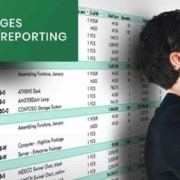Managing your risk – Why you need a Financial Consolidation system?
It is continually surprising to observe the number of ASX-listed organizations lacking robust systems to generate consolidated financial statements and notes to the accounts. Directors of companies are obligated to exercise due care and diligence under the Corporations Act 2001, which includes financial reporting responsibilities. Financial statements and notes to accounts are required to adhere to accounting standards and accurately reflect the company’s consolidated financial position and performance.
Many organizations depend on Excel as the primary tool for preparing statutory consolidated financial statements. Although Excel is a useful tool, it is often not the most suitable system for producing consolidated financial reports. Excel is not a robust option, and numerous well-documented cases in Australia and abroad have shown that errors in Excel have led to significant financial reporting mistakes.
Dedicated applications designed for preparing consolidated financial accounts come with standard features and functionalities that enable financial accounting teams to prepare the accounts confidently. Without such an application, Financial Controllers or CFOs may encounter several challenges when producing consolidated financial accounts in Excel, including:
Reporting Challenges of Excel
- Multiple General Ledger Systems – It is very common that an organisation has multiple General Ledger systems, each containing its own unique Chart of Accounts (CoA). These Trial Balances need to be extracted and mapped to a common CoA. These ledger systems are typically always changing, for example the addition of new accounts or legal entities. Financial consolidation applications have tools designed for accountants to manage this CoA data mapping process.
- Currency Conversion – Many organisations have legal entities that report in other currencies and these need to be translated into AUD for consolidation purposes. Financial consolidation applications provide standard functionality to perform this currency conversion and report in multiple reporting currencies, for example AUD and USD.
- Preparation of Notes to Accounts – The notes are used to make important disclosures that explain the numbers in the financial statements of a company. Common notes to the financial statements include accounting policies, depreciation of assets, inventory valuation, subsequent events, etc. These notes are typical complex to prepare and often require data from a variety of different data sources.
- Intercompany Eliminations – Excel does not automatically post intercompany elimination and consolidation journals. In Excel, there is no standard ability to produce a mismatch report or maintain an audit trail of changes made to your data.
- Data Validation – Most consolidation applications have multiple layers of data validation in order to minimise reconciliation issues. If Excel is used, it is difficult to achieve a similar level of the checks and balances required to have complete confidence in your financial reports.
- Partial Ownership – Many companies have various subsidiaries/entities that are not fully consolidated into financial statements. Most consolidation applications have the ability to apply appropriate accounting equity rules to ensure that entities are correctly consolidated. Excel typically does not have this functionality.
- Workflow – Financial consolidation reports are typically prepared by a team of financial accountants. Workflow is difficult to manage in Excel as Excel files need to be distributed to various stakeholders and you cannot control last minute adjustments and changes. A dedicated consolidation application not only improves the efficiency and workflow of staff to assist with closing financial accounts, but can also ensure last minute or post close adjustments are not made without approval.
- Security & Audit Features – When it comes to accountability, tracking user actions is crucial. This cannot be achieved in Excel.
- Financial Statement Reporting – When preparing the financial statements there are typically many different views of the data that need to be represented. This may be by Product Groups, or Regions. A dedicated consolidation application can make this data easy to present in a variety of reporting views.
Reporting Challenges of only using an ERP
Can you implement a financial consolidation system within ERP applications? Some ERP applications contain some basic consolidation functionality, however there are a number of typical shortcomings with this approach:
- Mergers, Acquisitions & Disposals – often many large companies are undertaking M&A activities. If you have just made a large acquisition, how will you produce your financial consolidated statements? Your ultimate goal might be to move the organisation to your core ERP, however these projects can typically take many months or years. Consolidation applications have tools that allow you to easily extract the Trial Balance from the General Ledger of a new organisation and map the CoA to your common consolidated financial reporting CoA. Compared to an ERP migration, this can be done in a very short time frame.
- Notes to the Accounts – Some ERP applications provide functionality to post elimination journal entries, but they do not provide a facility to create notes to the accounts. Again, we too often see organisations attempting to perform this task within Excel with its associated short comings.
- Flexibility – reporting requirements and accounting standards are continually changing and evolving. Typically, ERP applications are not very agile environments and change is often difficult, time consuming, and costly to implement.
- Costs – We are often surprised by the large investments that organisations make to enable financial consolidation within an ERP application. An application designed specifically for financial consolidations can be implemented for a fraction of the cost.
Specific financial consolidation applications are not costly to implement or maintain. Such applications can significantly lower audit fees for an organization. When standard end-of-year journal entries are utilized within these applications, they usually require only a single audit and approval by external auditors. In contrast, when spreadsheets are employed, they often necessitate a full audit annually.
As a Financial Controller, CFO, or Director of a major ASX listed company, I would avoid risking my personal or the organization’s reputation by relying on Excel for producing consolidated financial reports. The stakes are simply too great.
DAMIAN TIMMS




Leave a Reply
Want to join the discussion?Feel free to contribute!